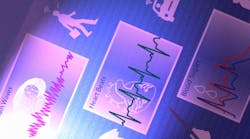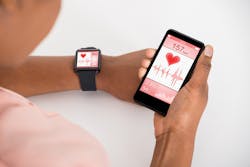Digital-health technologies are giving us more tools to uncover revealing patterns about our well-being. One case in point involves wearable consumer fitness applications. These wearables are moving toward a predictive healthcare mode, bringing with them the promise of more accurate insights for even more effective preventive measures.
Counting steps to measure your fitness level is a start—and only scratches the surface of what sensor, machine learning, and wearable technologies can deliver. Imagine if you could continuously collect a host of vital-sign data from an armband, a patch, a piece of jewelry, or clothing. The data then gets analyzed to produce insights for you and your doctor.
Such information could trigger alerts that send you to a doctor visit, warn you of potential health risks, or help you monitor and manage an existing condition. These insights could also reduce the frequency of doctor or clinic visits and lab tests. Picture the potential for more personalized, proactive healthcare—even in locations with limited access to medical professionals.
Insulin patches are just one example of healthcare wearables that can enable better self-treatment.
Reducing Healthcare Costs
In addition to enhancing healthcare, digital-health technologies also have the potential to disrupt the healthcare business model for the better. We all know that healthcare costs continue to rise. An April 2017 article in Fortune cited a U.S. government projection that the country’s healthcare bill would break the $10,000 per person mark for the very first time.1 Yet, despite the high costs, the returns aren’t impressive.
The article notes that what we’re getting for this spend is “a system where it takes weeks to see a doctor face-to-face, where more than 6,500 locales are officially deemed to have too few medical professionals to meet patients’ needs, and where U.S. health outcomes are consistently mediocre compared with those of many of our developed-nation peers (and even some of the less developed ones).” The promising news: a Forbes article from earlier this year notes that the digital-health revolution could save $300 billion in health expenditures, especially when it comes to managing chronic diseases.2
Full-scale healthcare reform will take the collaboration of various entities. Meanwhile, technology companies are driving a digital revolution that’s bringing virtual care to remote locations, enabling non-invasive self-monitoring and disease management, and helping people detect patterns and indicators of various health conditions and risks. The field of wearable health devices is a burgeoning area, and researchers in academia and industry are exploring techniques to create unobtrusive wearables that provide greater accuracy in measuring parameters such as blood-pressure trending, blood oxygen, blood glucose, hydration, and sleep quality.
For example, a materials scientist at Northwestern University has conducted trials on sensor-based wireless electronic patches that monitor vitals of premature babies.2 Kenzen, a health monitoring startup, is testing its ECHO Smart Patch system, which provides real-time sweat analysis to measure hydration, vital signs, and other key biometrics. Stanford University researchers have built a prototype of a wristband device that stimulates sweat on demand or periodically in order to measure the many biomarkers present in perspiration.3
These examples offer a window into how medical monitoring no longer needs to take place in a hospital. Patients, in turn, are empowered with more control over their healthcare. The days of having to wait for an annual checkup to uncover a health issue could eventually become a thing of the past.
Sensors Getting Smaller and Smarter
Semiconductor suppliers are producing many of the underlying technologies that make numerous digital-health applications possible. Analog front-ends are delivering electrocardiogram waveforms. Ultrasound imaging transceivers and receivers play important roles in imaging systems. Power-management ICs (PMICs) ensure that voltage levels in the wearable device are regulated, while battery chargers and battery fuel gauges help ensure reliable device uptime. Microcontrollers provide the processing power.
Sensor ICs, in particular, are taking center stage in enabling many digital-health applications. Industry analysts are projecting that the overall sensor market will grow to $2.5 billion by 2021. As they’ve become more sophisticated, more accurate, and smaller, sensors have emerged as essential components for collecting biometric data. Sensor technologies can measure parameters including body temperature, heart rate and pulse, glucose levels, and blood-oxygen levels.
To deliver accuracy, all of these ICs must be designed to perform well in the environment of the human body and against inherent design engineering challenges. Consider optical heart-rate monitors, which typically use photo plethysmography (PPG), an optical measurement of the volumetric change of blood in tissue from the cardiac cycle. Measuring PPG signals from a wearable involves overcoming challenges around signal-to-noise ratio, power consumption, ambient light cancellation, and motion compensation.
Wearable optical heart-rate monitors typically apply LEDs on the transmit path for the light source and photodiodes on the receive path to collect the light that refracts and reflects off of the blood flow to measure PPG. An architecture with a receive path that utilizes a current-mode, continuous-time, sigma-delta converter to convert the current directly from the photodiode has demonstrated success. Such an architecture offers a number of advantages—wide ambient cancellation range, power and area efficiency, high signal-to-noise ratio, and wide signal range.
Heart rate represents one of many health parameters that wearable devices can monitor.
Insights for a Healthier World
Design engineers are continuing to explore techniques to derive even greater accuracy from wearable healthcare devices. They’re also exploring different form factors (note the jewelry and clothing examples mentioned earlier). Prototyping platforms offer a simple way to evaluate IC components and accelerate the development cycle.
Maxim’s hSensor Platform, for example, integrates a variety of sensors for measuring heart and pulse rate, blood-oxygen levels, the heart’s electrical activity, and body temperature. The platform includes algorithms for various applications, including smart weigh scales, chest straps, ECG patches, bio authentication, and disposable temperature patches.
New and emerging digital-health technologies are not only enabling better preventive care on a personal level. Devices are already collecting massive volumes of data that, when aggregated together, have the potential to help medical professionals identify trends and patterns in population segments. None of this would be possible without semiconductor technologies and engineering ingenuity. That’s why engineers are playing a vital role in creating solutions to deliver insights that make a healthier world possible.
Andrew Burt is an executive business manager at Maxim Integrated, where he focuses on business development for the company’s healthcare sensors, optical modules, and algorithms, and also helps define new sensors that will be part of future wellness and disease-management solutions.
References:
1. http://fortune.com/2017/04/20/digital-health-revolution/
3. https://www.chemistryworld.com/feature/wearable-technology/3007085.article
4. https://www.nbcnews.com/health/health-news/new-wearable-health-tech-wrist-sensor-works-sweat-n747841



